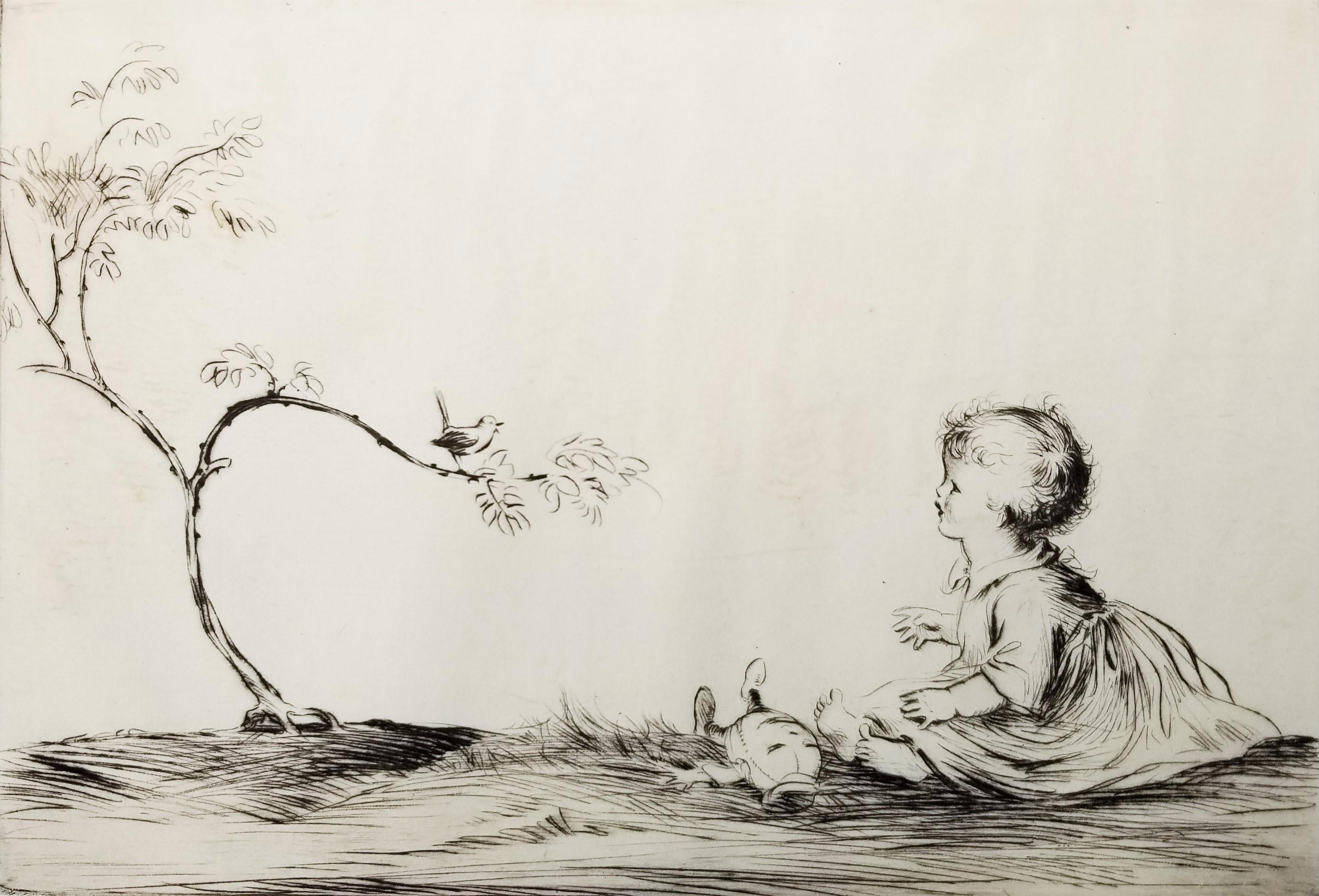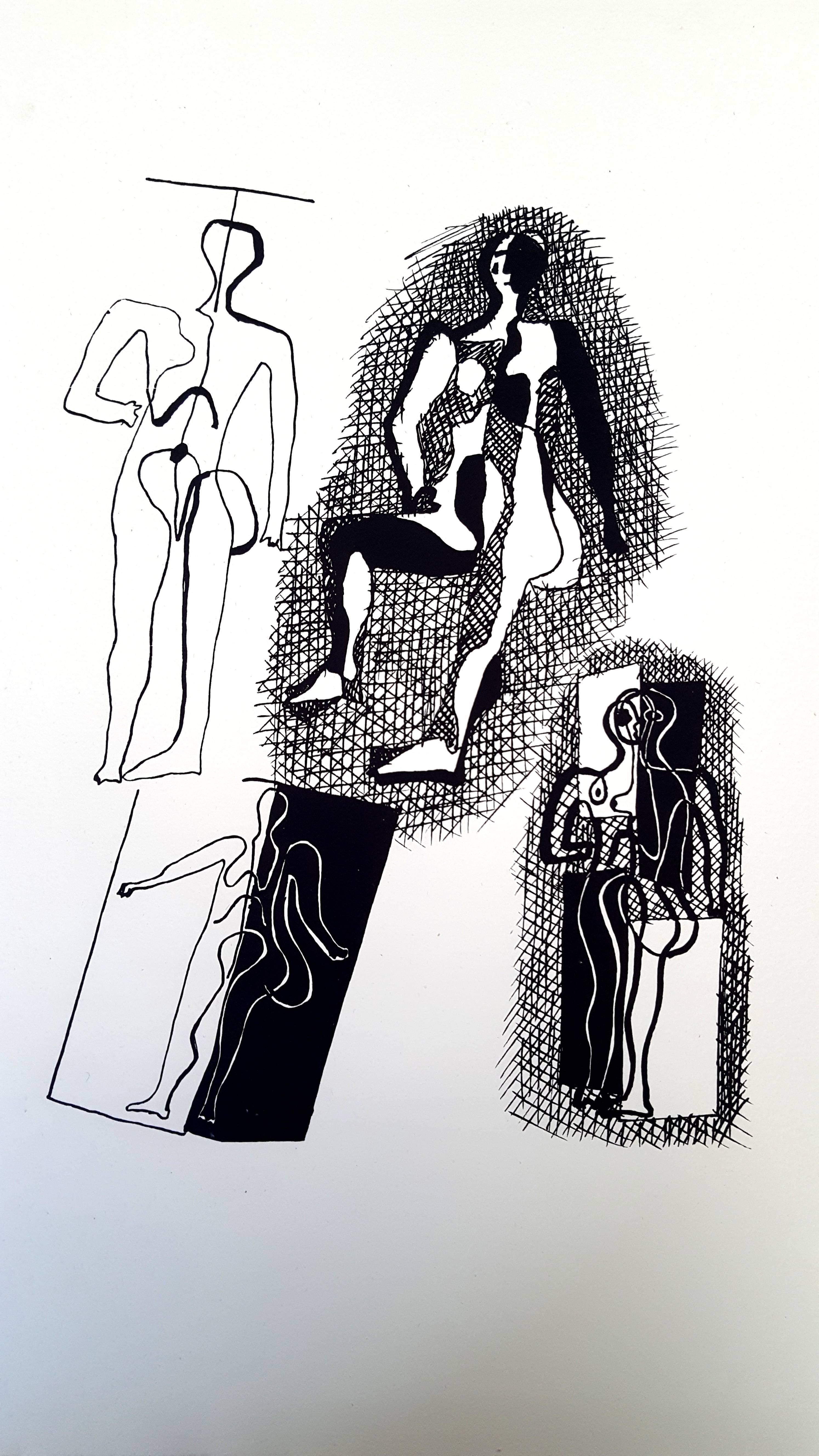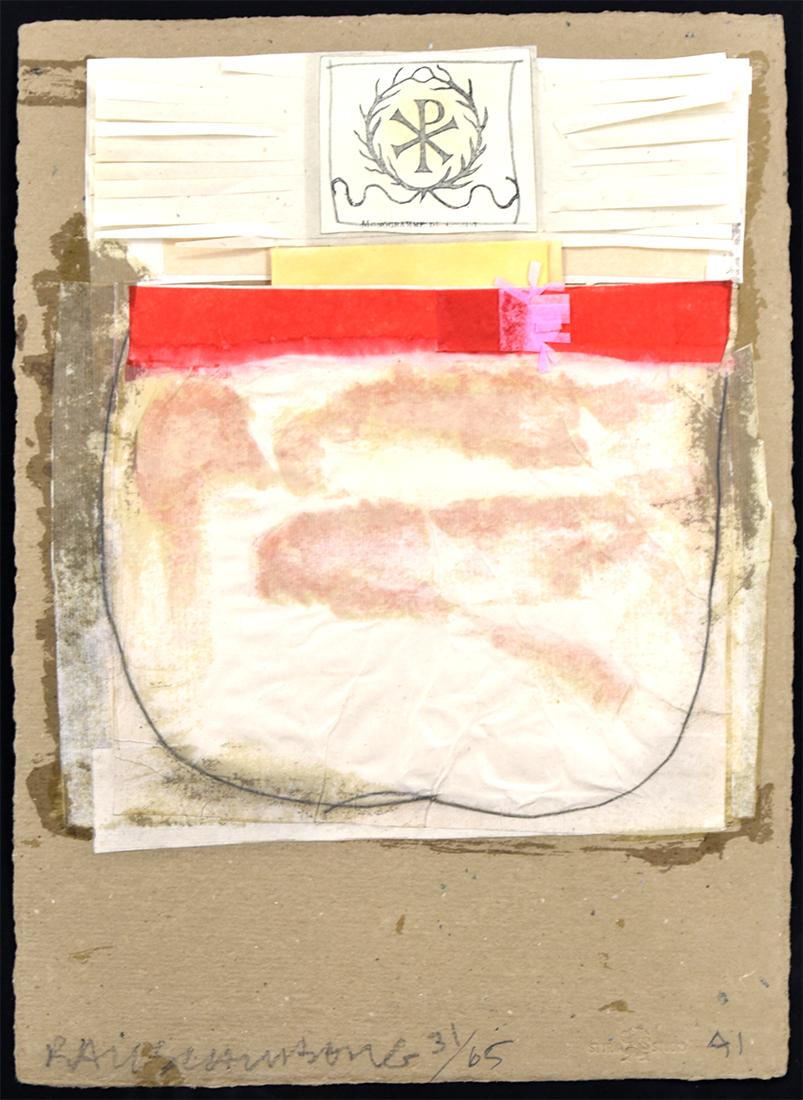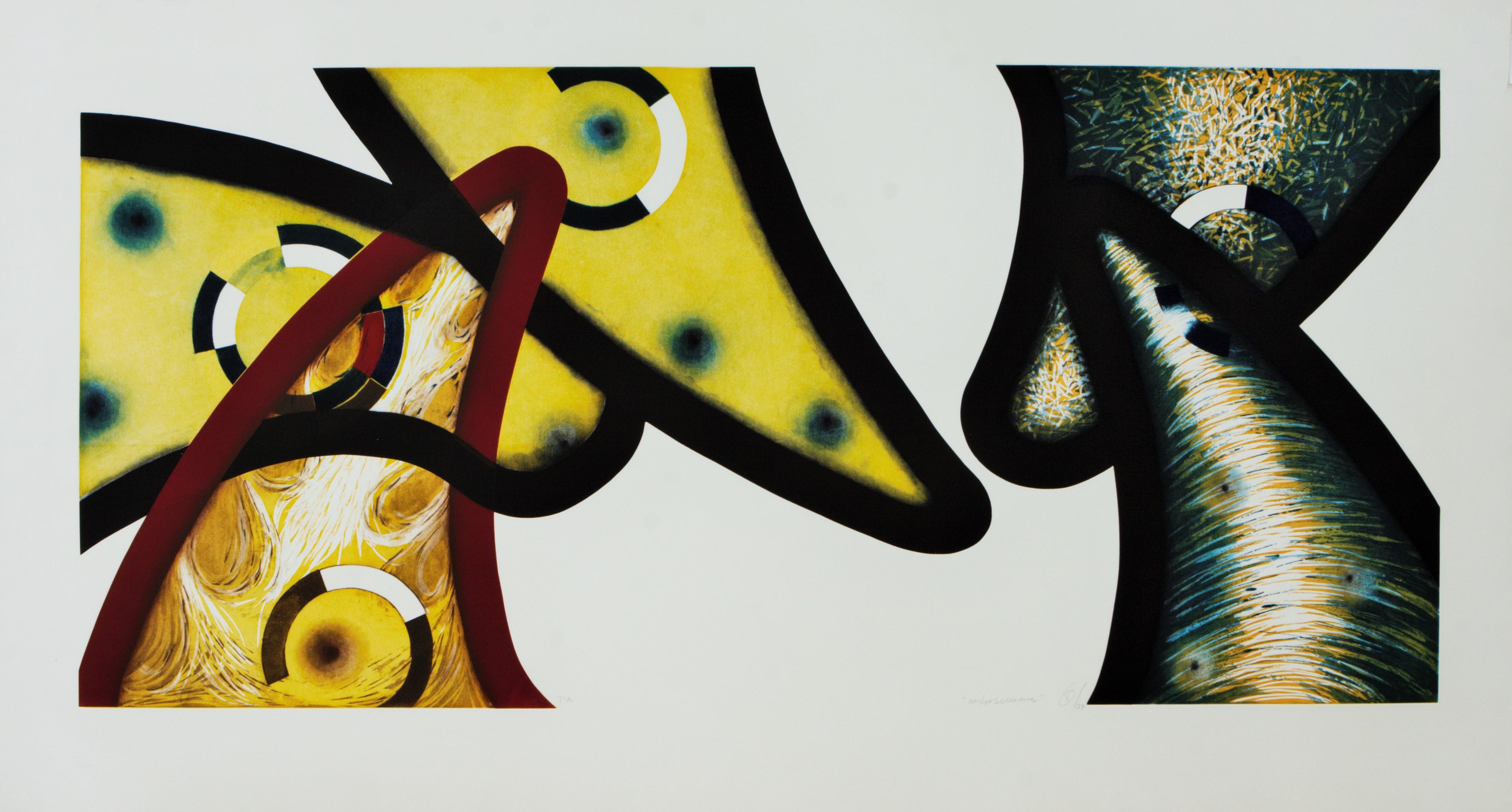Items Similar to Erotic Scene - Héliogravure by Micheal Von Zichy - 1911
Want more images or videos?
Request additional images or videos from the seller
1 of 5
Micheal Von ZichyErotic Scene - Héliogravure by Micheal Von Zichy - 19111911
1911
About the Item
The erotic scene is an original Héliogravure artwork on ivory-colored paper, realized by Micheal Von Zichy in 1911. Printed in only 300 copies, Leipzig; Privatdruck, from the Catalogue "Liebe" (Dear), Text in German on the plate, The drawing created unusually bold erotic subjects through deft strokes.
Good conditions with slight foxing on the lower.
Mihály Zichy (1827–1906) was a Hungarian graphic artist and painter, lived and worked in Paris and St. Petersburg. In 1853 he was appointed to the position of court artist for Alexander II of Russia.
- Creator:Micheal Von Zichy (1827 - 1906)
- Creation Year:1911
- Dimensions:Height: 11.82 in (30 cm)Width: 15.16 in (38.5 cm)Depth: 0.04 in (1 mm)
- Medium:
- Movement & Style:
- Period:
- Framing:Framing Options Available
- Condition:Insurance may be requested by customers as additional service, contact us for more information.
- Gallery Location:Roma, IT
- Reference Number:
About the Seller
4.9
Platinum Seller
These expertly vetted sellers are 1stDibs' most experienced sellers and are rated highest by our customers.
1stDibs seller since 2017
6,693 sales on 1stDibs
Typical response time: 2 hours
- ShippingRetrieving quote...Ships From: Grasse, France
- Return PolicyA return for this item may be initiated within 14 days of delivery.
More From This SellerView All
- Figures - Drypoint by Mino Maccari - Mid-20th CenturyBy Mino MaccariLocated in Roma, ITFigures is an Etching and Drypoint realized by Mino Maccari in the Mid-20th Century. Hand-signed in the lower right part. Good conditions. Mino Maccari (Siena, 1924-Rome, June ...Category
Mid-20th Century Modern Figurative Prints
MaterialsPaper, Drypoint, Etching
- Figures - Drypoint by Mino Maccari - Mid-20th CenturyBy Mino MaccariLocated in Roma, ITFigures is an Etching and Drypoint realized by Mino Maccari in the Mid-20th Century. Hand-signed in the lower right part. Numbered. Edition,3/40. Good conditions. Mino Maccari (Siena, 1924-Rome, June 16, 1989) was an Italian writer, painter, engraver and journalist, winner of the Feltrinelli Prize for Painting in 1963 and first winner of the Forte dei Marmi Satira Prize in 1973.After completing his secondary education, he enrolls in university. An interventionist like many young people of his time, he took part in the Great War at the age of nineteen as a field artillery officer. At the end of the conflict he resumed his university studies in Siena and in 1920 he graduated in law. In 1924 he was called by Angiolo Bencini to take care of the printing of the magazine Il Selvaggio, openly uncompromising fascist, revolutionary and anti-bourgeois, where his first engravings were published. After a few years of coexistence between work at the newspaper and the law firm, at the beginning of 1926 he left the legal profession to take over the direction of Il Selvaggio which he would hold until 1942. In 1928 he was the author of the small book published by Vallecchi (Florence), Il Trastullo di Strapaese (little songs and engraved woodwinds) which collected fascist songs (the same book was seized several times from Antonio Gramsci during his detention). With the transfer of the editorial staff of the Selvaggio in 1925 from Colle di Val d'Elsa to Florence, Maccari collaborated with Ardengo Soffici, Ottone Rosai and Achille Lega. In the meantime, between 1927 and 1930, he made himself known to the general public as a painter by participating in various national exhibitions. Also in 1930 Maccari works in Turin at La Stampa as editor-in-chief and has the writer Curzio Malaparte as director. His presence in the cultural and editorial world of the fascist regime is very intense, he writes and collaborates with various magazines: Quadrivio, L'Italia Letteraria, L'Italiano and Omnibus by Leo Longanesi; then, during the war, in il Primato di Bottai and, subsequently again, in Il Mondo di Pannunzio (from the first number, in 1949), up to Documento by Federigo Valli. His graphic production is also vast, ranging from the Album of Vallecchi (1925), Il trastullo di Strapaese (1928) to Linoleum (1931). Maccari illustrated in 1934 La vecchia del Bal Bullier by Antonio Baldini and in 1942 he published the Album folder, followed by Come quando fuori Piove and Il superfluo illustrata.For his pictorial work full of evident chromatic accentuations and fast brushstrokes, the violent drawing combined with the lively stroke of the graphic sign of his engravings, he is recognized by critics as a complete artist. In 1962 he was also entrusted with the presidency of the Accademia di San Luca in Rome and managed to obtain a personal exhibition at Gallery 63 in New York. His production of drawings, watercolors, temperas, etc. is endless, sometimes in collaboration with prestigious publishing houses; it is worth mentioning, just as an excellent example, the 32 b/w and color drawings with which he illustrated Il gusto di vivere, a volume that collects writings by Giancarlo Fusco, edited by Natalia Aspesi and published by Laterza in 1985. Maccari, Sienese and great contradaiolo della Torre, painted the Palio...Category
Mid-20th Century Modern Figurative Prints
MaterialsPaper, Drypoint, Etching
- Figures - Drypoint by Mino Maccari - Mid-20th CenturyBy Mino MaccariLocated in Roma, ITMid-20th Century. Hand-signed in the lower right part. Numbered. Edition 1/12. Good conditions. Mino Maccari (Siena, 1924-Rome, June 16, 1989) was an Italian writer, painter, engraver and journalist, winner of the Feltrinelli Prize for Painting in 1963 and first winner of the Forte dei Marmi Satira Prize in 1973.After completing his secondary education, he enrolls in university. An interventionist like many young people of his time, he took part in the Great War at the age of nineteen as a field artillery officer. At the end of the conflict he resumed his university studies in Siena and in 1920 he graduated in law. In 1924 he was called by Angiolo Bencini to take care of the printing of the magazine Il Selvaggio, openly uncompromising fascist, revolutionary and anti-bourgeois, where his first engravings were published. After a few years of coexistence between work at the newspaper and the law firm, at the beginning of 1926 he left the legal profession to take over the direction of Il Selvaggio which he would hold until 1942. In 1928 he was the author of the small book published by Vallecchi (Florence), Il Trastullo di Strapaese (little songs and engraved woodwinds) which collected fascist songs (the same book was seized several times from Antonio Gramsci during his detention). With the transfer of the editorial staff of the Selvaggio in 1925 from Colle di Val d'Elsa to Florence, Maccari collaborated with Ardengo Soffici, Ottone Rosai and Achille Lega. In the meantime, between 1927 and 1930, he made himself known to the general public as a painter by participating in various national exhibitions. Also in 1930 Maccari works in Turin at La Stampa as editor-in-chief and has the writer Curzio Malaparte as director. His presence in the cultural and editorial world of the fascist regime is very intense, he writes and collaborates with various magazines: Quadrivio, L'Italia Letteraria, L'Italiano and Omnibus by Leo Longanesi; then, during the war, in il Primato di Bottai and, subsequently again, in Il Mondo di Pannunzio (from the first number, in 1949), up to Documento by Federigo Valli. His graphic production is also vast, ranging from the Album of Vallecchi (1925), Il trastullo di Strapaese (1928) to Linoleum (1931). Maccari illustrated in 1934 La vecchia del Bal Bullier by Antonio Baldini and in 1942 he published the Album folder, followed by Come quando fuori Piove and Il superfluo illustrata.For his pictorial work full of evident chromatic accentuations and fast brushstrokes, the violent drawing combined with the lively stroke of the graphic sign of his engravings, he is recognized by critics as a complete artist. In 1962 he was also entrusted with the presidency of the Accademia di San Luca in Rome and managed to obtain a personal exhibition at Gallery 63 in New York. His production of drawings, watercolors, temperas, etc. is endless, sometimes in collaboration with prestigious publishing houses; it is worth mentioning, just as an excellent example, the 32 b/w and color drawings with which he illustrated Il gusto di vivere, a volume that collects writings by Giancarlo Fusco, edited by Natalia Aspesi and published by Laterza in 1985. Maccari, Sienese and great contradaiolo della Torre, painted the Palio...Category
Mid-20th Century Modern Figurative Prints
MaterialsPaper, Drypoint, Etching
- Erotic Scene - Etching by Mino Maccari - Mid-20th CenturyBy Mino MaccariLocated in Roma, ITErotic Scene is an Etching and Drypoint realized by Mino Maccari in the Mid-20th Century. Hand-signed in the lower part. Good conditions. Mino Maccari (Siena, 1924-Rome, June 16, ...Category
Mid-20th Century Modern Figurative Prints
MaterialsPaper, Etching, Drypoint
- Erotic Scene - Etching by Mino Maccari - Mid-20th CenturyBy Mino MaccariLocated in Roma, ITErotic Scene is an Etching and Drypoint realized by Mino Maccari in the Mid-20th Century. Hand-signed in the lower part. Good conditions. Mino Maccari (Siena, 1924-Rome, June 1...Category
Mid-20th Century Modern Figurative Prints
MaterialsDrypoint, Paper, Etching
- Erotic Scene - Etching by Mino Maccari - Mid-20th CenturyBy Mino MaccariLocated in Roma, ITErotic Scene is an Etching and Drypoint realized by Mino Maccari in the Mid-20th Century. Hand-signed in the lower part. Good conditions. Mino Maccari (Siena, 1924-Rome, June 1...Category
Mid-20th Century Modern Figurative Prints
MaterialsPaper, Drypoint, Etching
You May Also Like
- Spring Song /// Antique Female Artist Children Child Etching British ArtBy Eileen SoperLocated in Saint Augustine, FLArtist: Eileen Alice Soper (English, 1905-1990) Title: "Spring Song" *Signed by Soper in pencil lower right Year: 1924 Medium: Original Etching on cream laid paper Limited edition: 178 Printer: Likely printed by Eva Soper, London, UK Publisher: H C Dickens, London, UK Reference: "The Catalogue Raisonne of Prints and Etchings of George and Eileen Soper" - Beetles No. 83, page 119, 141, 157 Sheet size: 8.13" x 10.13" Image size: 6.63" x 9.63" Condition: Paper trimmed in the margins. A few faint areas of discoloration. It is otherwise a strong impression in very good condition Notes: Provenance: private collection - Boulder, CO. Biography: Eileen Soper was born in 1905 in the Municipal Borough of Enfield and moved to the house where she was to spend the rest of her life in Harmer Green, Welwyn in the Hertfordshire countryside in 1908. The house she later named "Wildings" was built by her father, the artist George Soper...Category
1920s Modern Figurative Prints
MaterialsIntaglio, Drypoint, Laid Paper, Etching
- Pablo Picasso (after) Helene Chez Archimede - Wood EngravingBy (after) Pablo PicassoLocated in Collonge Bellerive, Geneve, CHPablo Picasso (after) Helene Chez Archimede Medium: engraved on wood by Georges Aubert Dimensions: 44 x 33 cm Portfolio: Helen Chez Archimede Year: 1955 Edition: 240 (Here it is on...Category
1950s Modern Figurative Prints
MaterialsWood, Archival Paper, Engraving
- Untitled (Christian Symbol) from the North African Collage seriesBy Robert RauschenbergLocated in Palo Alto, CACreated in 1952, this Engraving, paper, cut paper, tissue paper and graphite on paper mounted on paperboard is hand-signed by Robert Rauschenberg (Port Arthur, 1925 - Captiva, 2008) in pencil in the lower left margin. Numbered from the edition of 65 in pencil in the lower left margin. About the Framing: Framed to museum-grade, conservation standards, Robert Rauschenberg Untitled (Christian Symbol) from the North African Collage...Category
1950s Modern Figurative Prints
MaterialsPaper, Tissue Paper, Graphite, Engraving
- L'Etreinte. II (Embrace)By (after) Pablo PicassoLocated in Palo Alto, CACreated in 1933, this Etching with Drypoint on Montval laid paper is stamped by the Picasso Estate Collection via Marina Picasso on verso and is a rare proof, aside from the numbered...Category
1930s Modern Figurative Prints
MaterialsLaid Paper, Drypoint, Etching
- Victor Guadalajara, "Intersections", 2009, Woodcut 16x12inBy Victor GuadalajaraLocated in Miami, FLVictor Guadalajara (Mexican, 1965) 'Intersecciones', 2009 Woodcut and Aquatint 100.00 x 185 cm. (39.4 x 72.8 in.) Edition of 30 UnframedCategory
Early 2000s Modern Abstract Prints
MaterialsPaper, Ink, Engraving, Etching, Woodcut
- Colosseum (First State)By Armin LandeckLocated in Middletown, NYCopper plate engraving on cream wove paper, 18 1/4 x 13 3/8 (462 x 338 mm), full margins. Signed in pencil, lower right. Edition of 20. First state (of 2). Minor uniform toning, and ...Category
Mid-20th Century American Modern Landscape Prints
MaterialsEngraving, Handmade Paper
Recently Viewed
View AllMore Ways To Browse
Antique Erotic
Erotic Antique
Antique Erotic Drawings
Micheal Von Zichy
American Graffiti Poster
Human Figure Glass Sculptures
Picasso Mother Child
Medical Heart
The Minotaur
Rodin Hand Sculpture
Horse Print Dress
Vintage Break Dancing
Art By Cheret
Jean Cocteau Hand Signed
Pen Chest
Marc Chagall Derriere
Breton Jewelry
Cobra Art Sculpture





